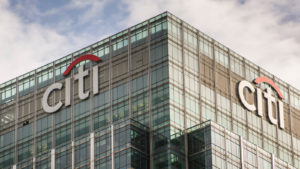However, this take is not founded in reality, as this concept of increased consumer spending habits three years after a stimulus check simply doesn’t line up with the exorbitant rates at which the cost of living in America is rising. For example, both the rental and housing markets have grown by 21.7% and 47%, respectively. Moreover, a recent discussion on the internet has uncovered that a normal order from Walmart (NYSE:WMT) has increased by over 200% since two years ago.
As a result, Americans are feeling the squeeze more than ever, and the best financial stocks are those that establish themselves as providers of relief in this difficult time.
Wells Fargo (WFC)

Wells Fargo (NYSE:WFC) stock has seen relatively unimpressive growth of only 6% for the year, but it does hold one strong driver of revenue, which is its mortgage holdings of $78 billion. As one of the top 10 mortgage lenders in the country, WFC stock has a strong financial base due to the number of homebuyers currently locked in their mortgages due to the stark difference in lending rates from three years ago to today.
As such, WFC will likely continue to perform well in the coming year until the Federal Reserve makes real progress towards cutting rates. However, even if lending rates drop, there’s no guarantee that current homeowners will rush to sell their houses in favor of new mortgages. Even if they do, there’s a good chance they’ll go to Wells Fargo for the new loan. As such, investors may want to consider Wells Fargo on their shortlist of stocks as the housing market reaches new highs in valuation.
JPMorgan Chase (JPM)

As far as lending goes, the world’s largest bank, JPMorgan Chase (NYSE:JPM) has shown exceptional resilience throughout the year. With $72.6 billion in mortgage holdings and over $600 billion in credit card purchases through its balances, JPM has exceptional debt from which to derive interest payments.
As a result, the stock has maintained a relatively strong growth of 22% year-to-date, outperforming the S&P 500 slightly. Moreover, with so many consumers relying on its services already for making ends meet and obtaining housing, there’s a good chance JPM stock will continue to grow as cash becomes more and more expensive to the average American.
For now, JPM also benefits from elevated rates due to the higher interest it can charge alongside the fact that its customer base could increase should interest rates fall and buyers re-enter the housing market.
Citigroup (C)

While also known for its major banking services, Citigroup (NYSE:C) has built a niche for itself in the credit card business by making balance transfers exceptionally attractive. That’s because Citi has tapped into the ease of delaying debt payments by offering competitive terms on its cards, like 0% APR for 21 months from the first transfer.
For Americans burdened by credit card debt, such a delay in performing a balance transfer from one high-interest card to one temporarily can be a much-needed reprieve. As a result, Citi has been able to amass significant ownership of credit card purchases of $287.2 billion in 2023.
Thus, as the American consumer credit card debt surpasses $1.14 trillion this year, stocks like C that prioritize interest revenue are likely to soar. Ultimately, investors also have the investment banking side of C stock to back up their buying as well.
On the date of publication, Viktor Zarev did not have (either directly or indirectly) any positions in the securities mentioned in this article. The opinions expressed in this article are those of the writer, subject to the InvestorPlace.com Publishing Guidelines.
On the date of publication, the responsible editor did not have (either directly or indirectly) any positions in the securities mentioned in this article.
Viktor Zarev is a scientist, researcher, and writer specializing in explaining the complex world of technology stocks through dedication to accuracy and understanding.
